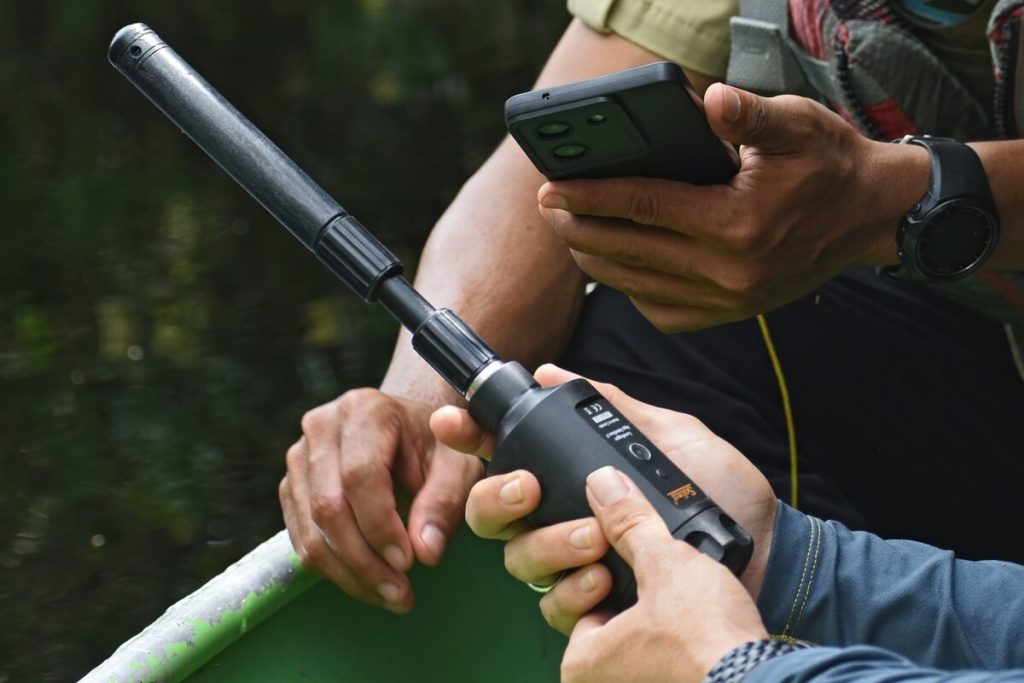June 24, 2025
In the heart of Sumatra’s lowland tropics, the Restorasi Ekosistem Riau (RER) program is working to protect and restore one of the planet’s most vital ecosystems: Peatlands. These carbon-rich landscapes play a critical role in regulating the global climate, while also preserving biodiversity and preventing wildfires. Underpinning all these functions is a deceptively simple yet essential element—water.

Water is essential for peat formation – without it, peat cannot accumulate. Understanding and managing peat water is therefore central to RER’s forest protection strategy. Through a combination of science, technology, and ground-level expertise, RER is implementing a multi-faceted monitoring system, designed to safeguard the long-term health of this region’s precious peatland ecosystems.
The Role of Water in Peatlands
Peatlands are unlike other forest ecosystems. Although they cover only about 3 percent of the Earth’s land surface, they store more than twice as much carbon as all the world’s forests combined. Formed over thousands of years by the accumulation of organic matter in waterlogged conditions, peat soils act like a sponge, storing vast amounts of carbon and water. But this delicate balance is easily disrupted.
“When the water table drops, peat becomes exposed to air and begins to oxidise,” explains Muhammad Iqbal, Restoration Ecologist at RER. “That not only releases carbon dioxide into the atmosphere but also creates dried-out peat that highly flammable, and that’s why monitoring peat water levels is essential to everything we do—from conservation, to restoration, and fire prevention.”
Dried-out peat is highly flammable because it consists of dense, organic material that, when drained, loses its natural moisture and becomes a porous, oxygen-rich fuel source. This makes it prone to smouldering fires that can burn underground for weeks, releasing large amounts of carbon and contributing to severe haze and climate impacts. To prevent this occurring, it’s essential to maintain high groundwater levels in peatlands and keep the soil saturated, thereby reducing fire risk and helping preserve the integrity of native vegetation and wildlife habitats.
Tracking Water, Preventing Fire
Indonesia’s history with peat fires is well known. Dry seasons, particularly during El Niño years, can rapidly turn degraded peatland into a tinderbox. To mitigate this risk, RER implements a rigorous peat management program with a strong emphasis on water monitoring.
“Water is our best line of defence,” explains Brad Sanders, RER’s Head of Operations. “Our monitoring system gives us real-time data to respond quickly if water levels start to drop, long before there’s any visible sign of risk on the surface.”
In addition to fire prevention, consistent monitoring helps RER evaluate the effectiveness of restoration activities, such as canal blocking, rewetting degraded peat domes, and natural regeneration. By tracking peat water levels over time, RER’s team of scientists can measure ecosystem resilience and adjust management strategies as needed.
Monitoring Methodology and Equipment at RER
To ensure accurate and consistent data collection, RER uses a combination of manual measurements and automated groundwater monitoring equipment. This monitoring system is designed to operate year-round, providing data even in remote field sites and in spite of challenging weather conditions.
Field teams use a specialized water monitoring kit, checking groundwater levels via dip-well measurements in strategic locations throughout the program’s restoration area. This approach is simple but highly effective, as it enables teams to track changes in the peat water table at regular intervals.
“In total, we’ve installed more than 100 groundwater monitoring points across our landscape,” says, RER’s Carbon Project Monitoring and Community Forest Officer. “The data is recorded and reviewed alongside climate and rainfall patterns; this gives us a detailed picture of how the ecosystem is behaving and whether additional interventions are needed.”
The RER team uses automatic level loggers, which can automatically record water level data at hourly intervals. These data are then manually downloaded every 3 months. These approaches form part of RER’s ongoing efforts to expand its capacity using the best water monitoring systems available for tropical peatlands.
From Data to Impact
Monitoring water provides an essential foundation for action. RER integrates peat water data into broader forest management decisions, including early warning systems for fire prevention, reforestation planning, and community engagement.
“Good data leads to good decisions,” notes Brad Sanders. “We can’t restore what we don’t understand. That’s why our team prioritizes both precision and consistency when it comes to peat water monitoring.”
The impact of all these efforts is already taking shape. Over the past decade, areas under RER’s management have shown a steady increase in peat water levels, along with a significant decline in fire incidence. During the dry season of 2023, which was particularly severe, RER recorded zero wildfires across its project area; a significant achievement, made possible through a combination of early detection, continuous monitoring, and rapid response.
A Model for Peatland Protection
RER’s approach to monitoring water in peatland ecosystems is setting a new standard for restoration and conservation in Southeast Asia. Through the integration of technology, science, and traditional knowledge, the program demonstrates that peat management can be both effective and sustainable. As Muhammad Iqbal puts it, “Peat may look like mud, but it’s one of the most valuable ecosystems on Earth. Keeping it wet is our mission, and monitoring is how we do that.”
With continued investment in training, equipment, and collaboration, RER is not only protecting the landscape today but also building the resilience of ecosystems and communities for the future. For more insights, analyses, and information from the RER team, please read our latest report, which covers a decade of positive impacts in the peatlands of Riau.
RER demonstrates how business leadership in nature protection is helping to conserve some of our planet’s most valuable ecosystems. Strengthened by partnerships with local communities, conservation organizations, scientific researchers, and governments, we are building sustainable conservation models that benefit nature, advance science, and help to keep our planet’s last remaining peatlands intact.